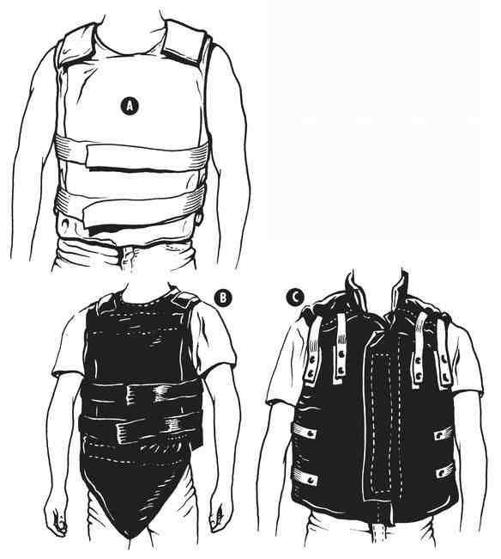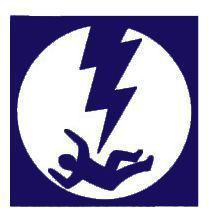SAS Urban Survival Handbook (111 page)
Read SAS Urban Survival Handbook Online
Authors: John Wiseman
Tags: #Health & Fitness, #Reference, #Survival, #Fiction, #Safety, #Self-Help, #Personal & Practical Guides, #General, #Survival Skills

There is every possibility that more than one bomb may have been planted—in more than one location. A bomb may be intended to target people who have just evacuated from the area where a warning has been given, or to kill police or anti-terrorist forces who are at the scene to investigate. The aim of a search, therefore, is to gather information over as wide an area as possible—not just in the location given in a warning.
Search procedure
Search strategy must be worked out in advance. Staff or individuals must understand their functions in a search and how to use any relevant equipment.
REMEMBER
The key to an efficient and fast search is familiarity with the area—if YOU know what belongs where, then you are more likely to spot something out of place! Keep the work area tidy!
The size of an individual’s search area depends on the number of available searchers and how familiar they are with the territory. In a complex environment—an oil refinery is a good example—each person can only search the limited area they are familiar with. If you have a work station—where the majority of your daily working time is spent—then this should be your search area.
If you are responsible for a wider working area or a group of staff, work out the minimum number of people necessary to carry out work-station searches. In an office this might mean two or three people searching desktops and floors for suspect devices before or while evacuating. Meanwhile, all other members of staff leave quickly and calmly.
If you are a bomb-threat officer or the person with overall responsibility, it is up to you to search other possible sites such as stairwells, lavatories, reception/meeting rooms. That done you can evacuate the building, taking with you a detailed floor plan for the police to refer to.
Once reunited at the designated muster point, staff must report the findings of their search:
- ◑ Nothing sighted—state area searched
- ◑ Possible sighting—give description and location
- ◑ Definite sighting—give description and location
By the time the police or bomb squad arrive a senior member of staff should be able to account for ALL personnel and visitors—the building should be FULLY evacuated. Give a good assessment of the presence of suspect devices. It should be possible to provisionally rule out some areas as being low-risk and direct the bomb squad to more likely locations.

WARNING
DO NOT re-enter the building/area until the all-clear has been given by the bomb squad. NO muster point for staff should ever be near enough to the building for people to be at risk from flying glass or debris, if the bomb explodes.
SEARCH RULES
- ■
Any unauthorized person found during a search should be treated with suspicion. The police will want to talk to them - ■
Search with your eyes ONLY—a search is visual NOT physical - ■
DON’T open cupboards/drawers/doors - ■
DON’T touch anything that looks suspicious - ■
Remove ONLY your own personal belongings - ■
Remain quiet—you should also be LISTENING for unusual noises (ticking, perhaps—although that’s a rather old-fashioned idea)
High-security lifestyle
The risk of attack or kidnap for a potential terrorist target can be reduced if the location and style of their accommodation are considered carefully. NEVER give the terrorist the advantage.
Densely-populated cities allow good communications with emergency services, usually have street lighting and may offer a choice of routes for journeys. It is easier to keep a low profile and to mingle in crowds—but this environment can favour the terrorist as well. Suburban areas may offer larger properties with private grounds. With adequate resources a perimeter wall/fence can offer good protection to a suburban home, but road routes into the centre of the city may be more of a problem, especially at rush hour.
Flats in apartment blocks usually offer limited access. The main building door can be equipped with an ‘entryphone’ and closed-circuit television (CCTV), but there may be more than one entrance. ‘Visitors’ might be admitted by other occupants of the building. Terraced houses have limited access but a detached house is preferable. If it is multi-storey, it offers better observation points. Ground-floor doors and windows, at least, MUST be made secure (see SECURITY).
A house in grounds should have a high perimeter wall, with the minimum number of entrances/exits. A drive or approach road should have speed bumps to slow cars. Garages/ car-parking areas should be well away from the house, well lit at night, with limited access. There should be no bushes, trees, or other obstructions within 50 metres (about 50 yards) of the house. Grounds should be floodlit at night. ALL security and alarm devices should be used (see SECURITY).
Personal bodyguards should supervise identification and admission of all visitors. Immediate access to potential targets should not be given to a visitor. A small delay—an offer of refreshment may be an excuse—allows security staff time to double-check visitor identity and assess possible terrorist risk. In a contact situation like a meeting or interview, the layout of the room is also important. The visitor should be offered a low, padded chair, with no arms. This makes it difficult to get up quickly. The potential target should sit behind a heavy desk which offers a protective barrier.
If a meeting is being held in private, a hidden panic button should be accessible in case of an emergency.
REMEMBER
To maintain security all household employees must be totally reliable, so great care must be taken when choosing staff. Strict vetting procedures MUST be followed, references checked and private life investigated. It is VITAL that staff are treated well and feel appreciated. Dissatisfaction with wages, conditions or any resentment towards the person they are protecting could lead to a breach of security.
BULLET/BLASTPROOFING
Bulletproof glass
This is made of several layers of glass and plastic. The laminate can be made as thick as required, and will stop all small arms fire. It is ideal in high-risk areas such as banks, post offices—anywhere where large amounts of cash are handled.
The glass is very heavy, which is partly why bulletproof cars/vans need special suspension. Bulletproof glass will also perform well if an explosion occurs. Like conventional laminated glass, there is little fragmentation.
Bulletproof clothing
Nowadays this is usually made from kevlar—an almost unbreakable man-made fibre. Its very long strands can be woven into almost any garment to protect the heart, lungs—all vital organs. Several layers may be used, depending on the seriousness of the threat—six layers will stop a bullet from a handgun. More layers are needed if the garment is to be any use against a magnum or special ammunition. If high-velocity rifles are likely to be involved, a ceramic plate is placed over the kevlar, but the disadvantage is that this makes the armour very bulky and inflexible—and detectable.
Kevlar’s enormous strength (and long fibre length) stops a bullet penetrating, but can’t stop the trauma of impact—a ‘trauma pack’ beneath a bulletproof vest is worn to dissipate the shock. It will still feel like you’ve been kicked by a mule.
All heads of state and high-risk personnel wear kevlar. In the US, in areas where there are spates of drive-by shootings or local battles going on, even children are sent to school in bulletproof clothing. It sounds extreme, but in one period in 1990 in Boston, 90 per cent of gunshot fatalities were innocent women and children caught in the crossfire of street fights.
Although kevlar will also stop grenade and bomb fragments from penetrating, it has been known to fail under impact from a knife or ice-pick. The head will always be vulnerable—there are ballistic helmets, but an important dignitary is unlikely to want to be seen wearing one to a function!
Bulletproof clothing has saved hundreds of lives, but doesn’t actually guarantee safety. Although the bullets won’t penetrate, there is likely to be bruising and even broken ribs. A company in the US (who claim to have saved many ‘important’ lives) actually demonstrate a bulletproof vest by having a man shoot himself. For the purposes of the demonstration he places two telephone directories under the vest to absorb the shock!
A lightweight vest (
A
), which can be worn inconspicuously under a shirt and jacket, may be more comfortable—but cannot offer full protection. Adding layers of ‘protection’ means adding bulk (
B
), but such a vest may still be worn under a coat. If subtlety’s not the aim, (
C
) as an outer garment offers good protection and mobility. Uniforms, jackets and overcoats are all available with varying levels of ‘protection’ built in.

Blastproofing
Most blastproofing is tailormade to the location—where blastproofing is possible at all. Cars tends to have layers of kevlar built into the bodywork or steel and plastic shielding. The underside of a car—vulnerable to bombs—can be made strong enough that a blast will lift the car but cause no actual damage within the vehicle.
Any building designed to withstand or contain a blast should have a bund—a blast wall—constructed around it. The roof should be designed to collapse inwards, not to fragment and fly off. The blast wave takes the route of least resistance, so partition walls and glass will be the first and most likely barriers to be blown away. ALL glass should be laminated to reduce the risk of flying fragments, which is the cause of a majority of casualties.
Blast blankets made of kevlar may be draped over an explosive device and weighted with sandbags to cut down the damage done by a blast.
REMEMBER
The majority of injuries caused by a bomb blast are from flying glass and debris. A muster point for the staff of a large building should ALWAYS be well away from this risk. If a bomb explodes near the general area where you are, do NOT go to inspect the damage. Terrorists sometimes use more than one device—to catch spectators and emergency services.
11
Disasters
Environmental changes may have increased the threat of
natural disaster. The restlessness of the planet may manifest itself in many ways, from floods to earthquakes—sometimes resulting in huge death tolls. Understand the dangers.
NATURAL DISASTERS
Morale • Predicting disaster • Emergency supplies • Supplies check list • Personal safety • Purifying water
EARTHQUAKE
The Richter Scale • Earthquake zones • Getting prepared • During the earthquake • After
VOLCANO
Eruption • Advance warnings • Emergency procedure • Nuée Ardenté
HURRICANE
Measuring hurricanes • Naming hurricanes • Early warnings • Getting prepared • During a hurricane • After the storm
TORNADO
Size • Destruction • Precautions
FLOOD
Getting prepared • During and after the flood • Flash floods
LIGHTNING
DROUGHT
The ‘greenhouse’ effect • Saving water • Living with drought
THE BIG FREEZE
Getting prepared • During bad weather • If you must go outside • Hypothermia
NATURAL DISASTERS
 Routine is the key to everyday living. It’s about getting up, remembering to take the dog for a walk, paying the electricity bill, going to work, and coming home to switch on the news and watch what has been
Routine is the key to everyday living. It’s about getting up, remembering to take the dog for a walk, paying the electricity bill, going to work, and coming home to switch on the news and watch what has been
happening to other people. Yet every day, somewhere in the world, disaster strikes, throwing normal life into chaos and reminding us that no matter how scientifically advanced our society, nature will always have the upper hand.